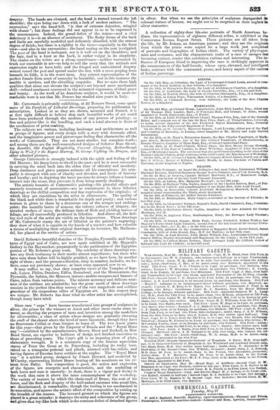FINE ARTS.
TEMPORARY EXHIBITIONS.
A MA rtnt.E statue of a Greek Slave by Mr. Hiram Powers, an American sculptor, is attracting crowds of fashionable visiters to Messrs. Graves's in Pall Mall, where it is exhibited to the best possible advantage. It repre- sents a youthful female figure, perfectly naked; the beauties of the matured form fully developed, yet chastely and with exact fidelity to nature. The attitude is nearly erect; only the right knee is bent, and the body is partially supported by the right hand resting on a post covered with drapery. The bands are chained, and the head is turned toward the left shoulder; the eyes being cast .lown with a look of modest sadness. "The expression," says the hand-bill, "is that of extreme dejection, mingled with shame "; but these feelings did not appear to us to be expressed in the countenance. Indeed, the grand defect of the statue—and a vital deficiency it is—is an absence of sentiment. The fleshy forms of the back and limbs are carefully modelled and delicately chiselled, with the utmost degree of finish; but there is a rigidity in the torso—especially in the front view—and also in the extremities: the hand resting on the post is crippled. The pose of the head is inelegant, nor is it well set on the shoulders; and the hair, tied in a knot at the back, is rather vulgar in its simplicity. The chains on the wrists are a cheap contrivance—neither warranted by truth nor excusable in art—to help to tell the story that the attitude and expression ought to have told; and the fringed and embroidered drapery wound round the post and spread under the feet, with a cross peeping from beneath its folds, is in the worst taste. Any correct representation of the perfect female form must of necessity be beautiful; and in this instance the marble is spotless, and the chiselling exquisite. But we miss those high qualities that alone can elevate the sculptor's art beyond mere mechanical skill—refined sentiment conveyed in the animated expression of ideal grace and beauty. As the work of an American sculptor, it would be more re- nntrkable were it not that Mr. Powers has studied nine years in Italy.



























 Previous page
Previous page